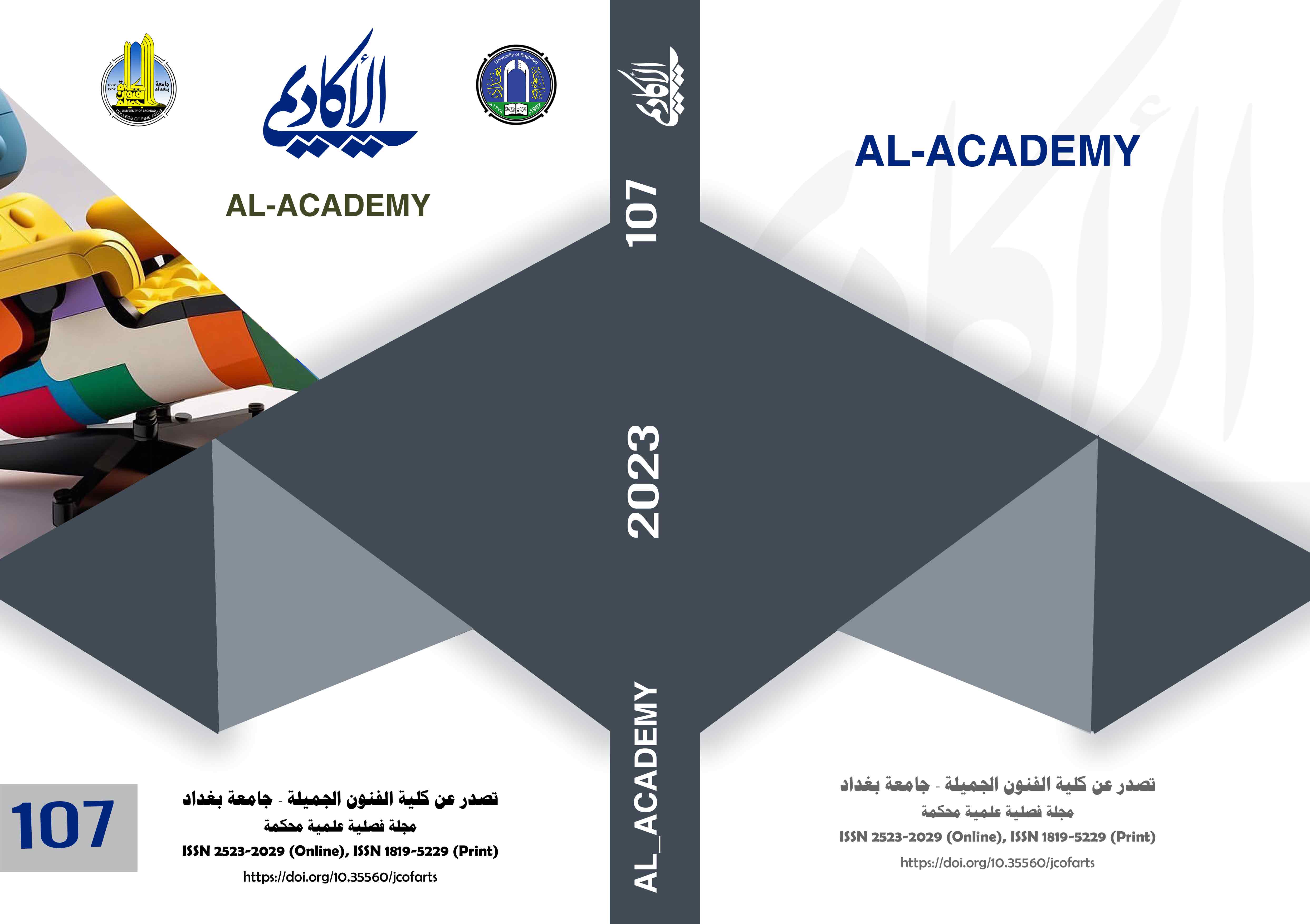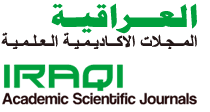Scenography and the effectiveness of meaning in the theatrical space
DOI:
https://doi.org/10.35560/jcofarts107/235-256Keywords:
Scenography, theatrical spaceAbstract
The elements of theater formation that fall within the spatial experience of the scenography of the show, which the directors work in in the imaginary theater, are important and have an aesthetic, intellectual and cognitive dimension, working to highlight reality in an aesthetic image surrounding space and space. And its relationship to the distinct, multiple and variable spaces above the stage, to produce theatrical signals and endless meanings through the possibility of infinite reconfiguration of the theater's space and its public and private space through the distribution of a group of blocks within the scenic image.
I dealt with in the first chapter (the methodological framework), which includes the research problem identified by the researcher, the importance of the research and the aim of the research, then the researcher determined the limits of the research and defined the terms and then defined them procedurally. The researcher also presented in the second chapter (the theoretical framework) two main topics: "Knowing scenography historically", the second topic is "the meaning of scenography in theatrical performance", and in the third topic "the aesthetics of scenography in the theatrical performance system", and then reviewed the most prominent indicators that resulted from the theoretical framework. The third chapter deals with the research procedures, and determines the research sample, the play "Red Carpet", scripted and directed by Dr. Jabbar Judy. And then in the fourth chapter, the results and conclusions were extracted, and recommendations and suggestions were made, in order to finally fix the references and sources of the research
References
Abd al-Nabi, A. A. (2005). The Employment of Cinematic Techniques in Theatrical Show. University of Baghdad, College of Fine Arts.
Abu Hilal al-Askari. (1983). the differences in language. Beirut: dar alafaq aljadidati.
Ahmed, K. b. (2002). Al-Maqees. Beirut: Dar al-Kutub al-Ilmiyyah.
Al-Barkawi, A.-F. (n.d.). Studies in the Semantics of Words and Linguistic Dictionaries. Al-Bayan and Al-Tabyeen, 33.
al-Dasouki, A. a.-R. (2005). Modern Media in Theater Scenography. Academy of Arts - Academic Notebooks 12, 17.
Al-Ghaith, A. H. (2012). Sudan: Sudan University of Science and Technology, Deanship of Scientific Research.
Al-Kasipopov. (1976). Integration in theatrical performance. In S. Shaker. Damascus: Ministry of Culture and Guidance.
Al-Masoudi, A. H. (2001). Aesthetics of Theatrical Space. Tunisia: University of Tunis, Higher Institute of Dramatic Art.
Al-Mousa, M. (2004). cenography between the Middle Ages and the Renaissance. Ofoq Magazine, 15.
Al-Sharqawi, J. (2002). The Foundations in the Art of Acting and the Art of Theatrical Direction. Cairo: The Egyptian General Book Organization.
Amin, N. (n.d.). Research in Theatrical Space. In D. Babli, nternational Festival for Experimental Theatre (p. 98). Cairo.
Antoine, A. (1979). le theatre libre. In d. M. Roueement, uressources ed slotkine (p. 45). Paris.
Appiah, A. (2005). The Function of Living Art and Other Essays. In A. H. Al-Rabat. Cairo: Ministry of Culture.
David, M. (1995). le theatre .
Décor. (2006). Retrieved from www. The decoration.com
Elias, M. (1997). Theatrical Dictionary. In H. K. Hassan, Theatrical Dictionary (p. 473). Beirut: Library of Lebanon.
Glossary of Art, Architecture & Design since. (1945).
Hamadeh, I. (n.d.). Dictionary of Theatrical and Dramatic Terms. Cairo: Dar Al-Shaab.
Howard, P. (2004). What is scenography. Ministry of Culture, Cairo International Festival for Experimental Theatre, 200.
Noun, M. F. (1993). The Art of Scenography and Areas of Expertise, Pamphlet (Scenography Today). Ministry of Culture, Publications of the Cairo Festival for Experimental Theatre, 8.
Pius, Z. (1980). Scenography, Foreign Culture Supplement. Publications of the Ministry of Culture and Information, Department of Cultural Affairs for Printing and Publishing, 128.
Scine Design and stage lighting. (2005). Retrieved from hppt / www bartelby.com
Shabelle. (2001). Plastic Space. In A. A. Arafa, Press.
souriau, E. (1999). vocabulaire d Esthetique ,Qudriaee. France: prisse universitaire.
speetaeles, l. d. (1965). Paris .
Ubersfeld, A. (n.d.). lui et le theatre.
von, M. F. (2003). Scenography Today. In I. H. others. Cairo: Publications of the Ministry of Culture, Fifth Cairo International Festival for Experimental Theatre.
Zaidan, A. a.-R. (n.d.). Issues of the Theoretical Foundation of Scenography, (Theatrical Studies). Tunisia: Publications of the Higher Institute of Dramatic Art.
ELMAHI, Z. (2022). Art as a therapy to relieve symptoms of Attention Deficit/Hyperactivity Disorder (ADHD), in children. Al-Academy, (106), 167–186. https://doi.org/10.35560/jcofarts106/167-186
bint Mohammad AlMutairi, S., & bint Ayed Alharbi , R. (2022). Inventory of Saudi youth trends towards choosing fashion accessories. Al-Academy, (106), 205–230. https://doi.org/10.35560/jcofarts106/205-230
Saleh Moraished, L., & Saleh Al-Saleh, M. (2022). The Relationship Between Using Diverse Materials to the Intellectual Context’s in the Art of Contemporary Ceramic. Al-Academy, (106), 253–270. https://doi.org/10.35560/jcofarts106/253-270
mohammed Alamri, M., & bint Mansour Abdul Aziz aljadid, M. (2022). Printmaking Techniques to Enable People with Visual Impairment to Taste Print Artworks. Al-Academy, (106), 297–318. https://doi.org/10.35560/jcofarts106/297-318
Gharsan Alshehri, H. . (2022). Role Of the Interactive Public Sculpture in Increasing Physical Activity . Al-Academy, (105), 57–80. https://doi.org/10.35560/jcofarts105/57-80
Ibrahim Alhulwah, N. ., Saud Alrasheed, E. ., & Almokhtar Lahyani, S. . (2022). The semiotics of the visual image of women in the discourse of empowerment, Saudi Arabia Kingdom as a model. Al-Academy, (103), 25–42. https://doi.org/10.35560/jcofarts103/25-42
Ahmad allaoui, L. . (2022). Textual thresholds and its Aesthetic in history: "Mamo Zain" by its author, the famous Kurdish poet Sheikh Ahmad Al-Khani, deceased (1118 AH / 707 AD), translated by Sheikh Dr. Muhammad Saeed Ramadan al-Bouti. Research on the connotation and manifestations of interconnection. Al-Academy, (103), 73–92. https://doi.org/10.35560/jcofarts103/73-92
mohamed Dammak, K. (2022). Transformations of the body from traditional expression to subjectivity : Marina Abramivic as a model. Al-Academy, (103), 149–164. https://doi.org/10.35560/jcofarts103/149-164
shafee, wafa H., & aboabat, A. A. (2021). Recycling waste toys to accessories suggested uniform for educational units in kindergarten stages. Al-Academy, (102), 63–80. https://doi.org/10.35560/jcofarts102/63-80
Ebraheem Mongy, Y. ., Amer Al-Hajri, S. ., & Al Mardhoof Al Saadi, N. . (2021). Inspiring heritage and symbols of local identity in contemporary Omani Graphic Art. Al-Academy, (102), 81–104. https://doi.org/10.35560/jcofarts102/81-104
Nasser AL Nahari , N. . (2021). The Role of Contemporary Interactive Art Works Economically and Culturally "An Analytical Study". Al-Academy, (102), 123–144. https://doi.org/10.35560/jcofarts102/123-144
Kalied Talib Alsamurai, A. . (2021). The communicative education of fine arts in the COVID-19 crisis and its manifestations in the modernization of the works of the Iraqi painter "Nabil Ali as a model". Al-Academy, (102), 207–222. https://doi.org/10.35560/jcofarts102/207-222
Daryanavard (al-ghaisi), Z., Balavi, R., & M. Bataineh, A. (2021). The Communicative Functions in The Speech of The UAE National Anthem in The Light of The Eloquence of The Audience. Al-Academy, (101), 145–156. https://doi.org/10.35560/jcofarts101/145-156
Abdullah Al-Qudairi, T. (2021). Designing Clothes that Meet the Functional and Aesthetic Needs of Children with Hip Dislocation. Al-Academy, (101), 157–184. https://doi.org/10.35560/jcofarts101/157-184
Abdulaziz Alfadda, A. (2021). Utilization of Design Principles of Nature in Innovating Contemporary Metal Products. Al-Academy, (101), 203–226. https://doi.org/10.35560/jcofarts101/203-226
Daryanavard, Z., Balavi, R., & Khezri, A. (2021). Semantic functions of repetitive synthesis in Adnan al-Sayegh’s poetry. Al-Academy, (100), 233–246. https://doi.org/10.35560/jcofarts100/233-246
Hassan Abu Hasna, R. (2021). The Utilization of Arabic Calligraphy to Inspire Modern Arabic Type Designs. Al-Academy, (100), 277–304. https://doi.org/10.35560/jcofarts100/277-304
Aldaawani, R. F. (2021). The semiotic of the Islamic blazon - a related analytical study between the Islamic blazon and its publicity message. Al-Academy, (100), 319–336. https://doi.org/10.35560/jcofarts100/319-336
Wafa Hassan, S., & Marram Zaid, A.-H. (2021). Sustainability by recycling palm waste in designing women’s belts. Al-Academy, (100), 337–356. https://doi.org/10.35560/jcofarts100/337-356
Kazem Odeh, R., & Khalaf Hussain, S. (2021). The effectiveness of media communication and its problems in the contemporary theatrical presentation. Al-Academy, (99), 155–168. https://doi.org/10.35560/jcofarts99/155-168
Saud Al-Hazza, H. (2021). Study of the participation of Saudi women in official visual arts exhibitions "Contemporary Saudi Art Exhibition as an Example". Al-Academy, (99), 311–328. https://doi.org/10.35560/jcofarts99/311-328
Ali Ahmed Abdel Rahman, R. (2021). Making use of economical design techniques and materials in implementing cosmetic supplements to the interior spaces of the dwelling. Al-Academy, (99), 329–348. https://doi.org/10.35560/jcofarts99/329-348
Al Saadi, N. (2021). Variables related to the performance styles of batik art to achieve linear tactile effects in the printmaking. Al-Academy, (99), 349–364. https://doi.org/10.35560/jcofarts99/349-364
Saad Algarni, M. (2021). Virtual Art Exhibitions In Times Of The Corona Pandemic. Al-Academy, (99), 441–480. https://doi.org/10.35560/jcofarts99/441-480
Abduljabbar AlEssa, A. (2020). Simulation As One Of The Tools Of Visual Thinking And Its Effect On Developing Drawing And Design Skills To Produce Innovative Artworks. Al-Academy, (98), 235–254. https://doi.org/10.35560/jcofarts98/235-254
Mohammed Al-Mutairi, S., Yousef Altwaijri, B., Yousef Al-Ali, R., & Abdul Hakim Almoqrin, S. (2020). Designing an E-marketing Website for Sustainable Fashion. Al-Academy, (98), 271–286. https://doi.org/10.35560/jcofarts98/271-286
A.A. FEDA, L. (2020). GIRL’S TRADITIONA COSTUME IN MAKKAH AL MUKARRAMAH _ KINGDOM OF SAUDI ARABIA”. Al-Academy, (98), 305–324. https://doi.org/10.35560/jcofarts98/305-324
Abdulhafeez, N. (2020). Novel Coronavirus Pandemic as it is Expressed by Children in Their Drawings On-line: An Analytical Study. Al-Academy, (98), 413–434. https://doi.org/10.35560/jcofarts98/413-434
Almamari, B. M. (2020). Appearance and Decay of Split-brain Theory to Explain Human Artistic Activity: A Historical Review. Al-Academy, (97), 261–270. https://doi.org/10.35560/jcofarts97/261-270
Abdulhafeez, N. (2020). The Philosophy of Beauty and Aesthetic Tasting in the Story of Yusuf, peace be upon him, with the Al-Azeez’s Wife in light of the sayings of Ancient Philosophers and Modernists. Al-Academy, (97), 241–260. https://doi.org/10.35560/jcofarts97/241-260
O Alzahrani, M. (2020). The Image of Women in Arab Media Advertisements. Al-Academy, (97), 299–320. https://doi.org/10.35560/jcofarts97/299-320
Abdulghaffar Feda, L. (2020). Recycling evening dresses into modern dresses with traditional features. Al-Academy, (97), 321–342. https://doi.org/10.35560/jcofarts97/321-342
Saud Alrasheed, E. (2020). Digitization is a contemporary reality and its importance in the Saudi plastic arts. Al-Academy, (96), 213–228. https://doi.org/10.35560/jcofarts96/213-228
Mohammed Alamri, M. (2020). Inspiration Of Typed Paintings From Folk Architecture In Asir Region. Al-Academy, (96), 229–250. https://doi.org/10.35560/jcofarts96/229-250
Murshed Alharbi, M., Alahmad, H., & Alsenan, M. (2020). Saudi society’s trends towards visiting museums and art galleries. Al-Academy, (96), 251–272. https://doi.org/10.35560/jcofarts96/251-272
kadim oda, russil, & fuad fadhel, L. (2020). Techniques of Acting Performance in Fantasy Theatrical Show. Al-Academy, (95), 5–18. https://doi.org/10.35560/jcofarts95/5-18
Mohammed taleb al dweik, S., abu taleb, S., & saber, M. (2020). The Role of the Passive Conditioning in Achieving Thermal Comfort in Temporary Hotel Units. Al-Academy, (95), 243–272. https://doi.org/10.35560/jcofarts95/243-272
Ibrahim Bin Hamdan, N. (2019). Creativity in the Draping on the mannequin of Young Girls Victorian Fashion between 1860-1890. Al-Academy, (94), 73–96. https://doi.org/10.35560/jcofarts94/73-96
Nassar Alajaji, T., & Abdulazez Almogren, H. (2019). The Effect of The Illustration Program on Fashion Design Inspired by Historical Costumes:. Al-Academy, (94), 97–114. https://doi.org/10.35560/jcofarts94/97-114
Nassar Alajaji, T., & Mohammed Alfulaij, W. (2019). Revival of the Heritage Using Porcelain Units Inspired by Traditional Sadou Decoration and Kufic Calligraphy in Fashion Design. Al-Academy, (92), 253–270. https://doi.org/10.35560/jcofarts92/253-270
Nawi, K. (2019). Time in the Cinema.The Two Films (The Knife and The Deceived) -A Model. Al-Academy, (91), 49–64. https://doi.org/10.35560/jcofarts91/49-64
alsayed Mustafa jawad ahmed, B. (2016). The Instagram from a media tool to a marketing tool. Al-Academy, (74), 195–212. https://doi.org/10.35560/jcofarts74/195-212
Khaled Taleb Al Samurai, A. (2018). The educational means used by teachers of art education in primary schools. Al-Academy, (89), 229–240. https://doi.org/10.35560/jcofarts89/229-240
Jassem Mohammed, N., & Taha yaseen, E. (2017). Structural Systems In The Design Of World Magazine Covers. Al-Academy, (86), 149–164. https://doi.org/10.35560/jcofarts86/149-164
al-Khalidi, A. S. (2017). The reality of interior design of Sharjah mosques and the possibility of development - selected models. Al-Academy, (83), 247–267. https://doi.org/10.35560/jcofarts83/247-267
kadim oda, R. (2016). Actor performance features in the types of theatrical silent. Al-Academy, (79), 225–238. https://doi.org/10.35560/jcofarts79/225-238
kadim oda, R. (2016). Indicative coding of the actor’s performance in the Iraqi theater show. Al-Academy, (77), 63–74. https://doi.org/10.35560/jcofarts77/63-74
Allawi Salal, A. ., & Kadim oda, russil. (2022). Actor’s skills in pantomime theater performances. Al-Academy, (105), 121–132. https://doi.org/10.35560/jcofarts105/121-132
kadim oda, russil, & fuad fadhel, L. (2020). Techniques of Acting Performance in Fantasy Theatrical Show. Al-Academy, (95), 5–18. https://doi.org/10.35560/jcofarts95/5-18
Kadim oda, russil, & Khalaf Hussain, S. (2021). The effectiveness of media communication and its problems in the contemporary theatrical presentation. Al-Academy, (99), 155–168. https://doi.org/10.35560/jcofarts99/155-168
Downloads
Published
Issue
Section
License
Copyright (c) 2023 sahib jiad asmaeil

This work is licensed under a Creative Commons Attribution 4.0 International License.













